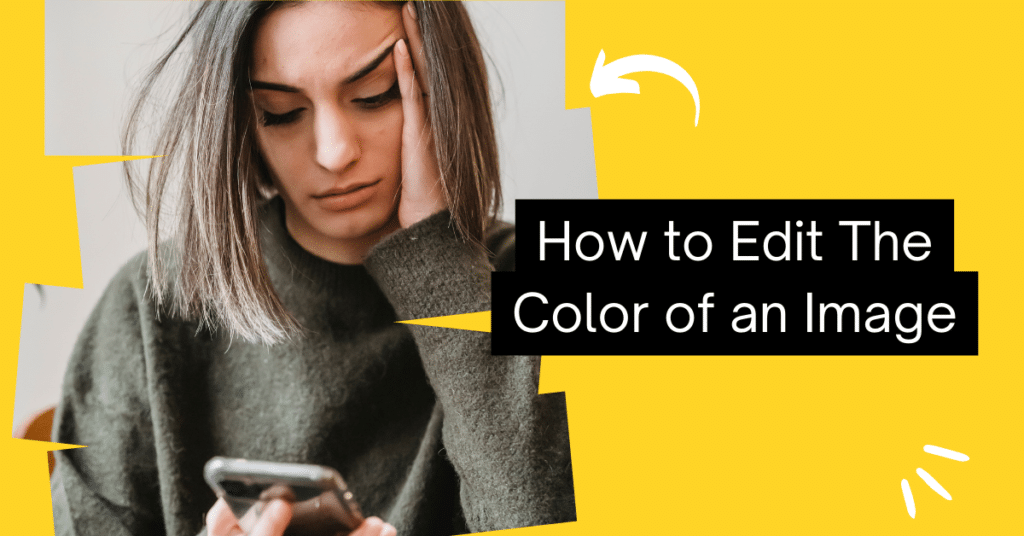How to Edit the Color of an Image
In the vast realm of visual content, the art of image color editing plays a pivotal role in shaping the narrative and visual appeal. The process involves strategically adjusting hues, saturations, and brightness levels to achieve a desired aesthetic. Understanding how to edit the color of an image is not merely a technical skill; it is a creative tool that empowers individuals and businesses alike to convey emotions, highlight focal points, and evoke specific responses from the audience.
Importance of Image Color Editing: Effective image color editing is more than just correcting tones; it’s about enhancing the storytelling capacity of visuals. Colors evoke emotions and set the tone of a message, making it crucial for content creators, marketers, and designers to master the art. Whether it’s creating eye-catching social media graphics or optimizing images for a professional website, the ability to edit image colors opens doors to a world of creative possibilities.
Overview of the Blog Post Purpose: This blog post serves as a comprehensive guide on how to edit the color of an image. It aims to demystify the intricacies of color editing, catering to both beginners and those seeking advanced techniques. From understanding the basics of color models to providing step-by-step instructions for common editing tasks, this post is designed to empower readers with the knowledge and skills needed to transform their images. Whether you’re a graphic designer, social media enthusiast, or someone looking to enhance personal photos, this guide will equip you with the tools to navigate the colorful world of image editing.
Table of Contents
Understanding Image Color Editing
Explanation of Why Image Color Editing is Essential: Image color editing stands at the core of visual storytelling, serving as a vital tool for conveying messages, emotions, and brand identity. Colors have the power to evoke specific feelings and reactions, influencing how viewers perceive and engage with visual content. Whether it’s enhancing the vibrancy of a product image or creating a mood in a photograph, understanding how to edit the color of an image is essential for anyone looking to communicate effectively through visuals.
Benefits of Enhancing or Changing Image Colors: The benefits of mastering color editing extend beyond mere aesthetic improvements. Enhanced image colors can captivate attention, improve visual appeal, and create a lasting impression. For businesses, this translates into increased brand recognition and customer engagement. Additionally, in personal photography, the ability to adjust colors allows individuals to highlight specific elements, evoke desired moods, and turn ordinary images into visually striking works of art.
Common Scenarios Where Color Editing is Required: Color editing is not confined to a specific niche; it is a versatile skill applicable in various scenarios. From correcting the lighting conditions of a poorly lit photograph to adjusting color tones for a cohesive social media feed, the need for color editing arises in numerous situations. Professionals in graphic design, marketing, and photography regularly engage in color editing to ensure their visuals align with their objectives and resonate with their target audience. Whether it’s for business or personal use, understanding when and why to edit image colors is crucial for achieving desired outcomes.

Basics of Image Color Editing
Introduction to Fundamental Concepts: To master how to edit the color of an image, it’s crucial to grasp fundamental concepts such as hue, saturation, and brightness. Hue refers to the dominant color in an image, saturation measures the intensity of colors, and brightness determines the overall lightness or darkness. Understanding these elements provides the foundation for precise and intentional color adjustments, enabling users to achieve desired visual effects.
Overview of Color Models (RGB, CMYK) and Their Significance: Color models, specifically RGB (Red, Green, Blue) and CMYK (Cyan, Magenta, Yellow, Black), are essential frameworks in image color editing. RGB is commonly used for digital displays, while CMYK is prevalent in print. Knowing when to use each model is key to producing accurate and consistent results. RGB is additive, combining light to create colors, while CMYK is subtractive, involving the layering of inks. This distinction is vital for professionals working in both digital and print media.
Tools and Software Commonly Used for Color Editing: An integral part of learning how to edit the color of an image is becoming familiar with the tools and software available for color editing. Popular choices include Adobe Photoshop, Lightroom, and GIMP, each offering a range of features for precise color adjustments. These tools provide users with the flexibility to manipulate hues, saturations, and brightness levels, empowering them to achieve the desired visual impact. Understanding the capabilities of these tools is essential for efficiently and effectively editing image colors.
Step-by-Step Guide: Editing Image Colors
Choosing the Right Software or Tool for Editing: The journey of learning how to edit the color of an image begins with selecting the appropriate software or tool. Depending on your familiarity and requirements, popular choices like Adobe Photoshop, Lightroom, or free alternatives like GIMP offer a spectrum of features. Choosing the right tool ensures a seamless editing experience, catering to both beginners and advanced users.
Uploading and Opening the Image in the Selected Tool: Once you’ve chosen your preferred software, the next step is uploading and opening the image within the selected tool. Most editing software provides a straightforward interface for importing images. This step sets the stage for the subsequent adjustments, allowing you to work on the image with precision and ease.
Adjusting Hue, Saturation, Brightness, and Contrast: With the image loaded, the core of color editing involves adjusting key parameters – hue, saturation, brightness, and contrast. Understanding the impact of each adjustment is crucial. Tweaking the hue alters the dominant colors, saturation controls intensity, brightness influences overall lightness, and contrast accentuates the differences between tones. A balanced approach to these adjustments ensures harmonious and visually appealing results in your edited image.

Advanced Techniques for Image Color Editing
Introduction to Advanced Features in Editing Tools: As you delve deeper into mastering how to edit the color of an image, it’s essential to explore the advanced features within editing tools. Leading software like Adobe Photoshop offers a plethora of sophisticated tools beyond basic adjustments. Familiarizing yourself with these features unlocks a realm of possibilities, allowing for nuanced and intricate color manipulations.
Exploring Gradient Maps, Color Grading, and Selective Color Adjustments: Beyond the basics, advanced color editing involves techniques like gradient maps, color grading, and selective color adjustments. Gradient maps enable mapping of specific colors to tonal ranges, while color grading allows for the application of specific color tones for artistic effects. Selective color adjustments empower you to target and modify individual colors within an image. These techniques provide a level of precision and creativity that elevates your color editing capabilities.
Case Studies Demonstrating the Impact of Advanced Techniques: To fully comprehend the potential of advanced color editing techniques, examining real-world case studies is invaluable. Explore examples where professionals have utilized gradient maps for thematic consistency, applied color grading to evoke specific moods, and employed selective color adjustments to highlight focal points. These case studies serve as inspiration and practical insight, showcasing the transformative impact advanced color editing can have on diverse visual projects.
Common Mistakes to Avoid
Over-saturation and Color Distortion Pitfalls: While mastering how to edit the color of an image, it’s crucial to navigate potential pitfalls, such as over-saturation and color distortion. Overusing saturation can lead to unnatural and overly vibrant colors, diminishing the visual appeal. Careful adjustments are paramount to maintain a balanced and realistic representation of hues without succumbing to the temptation of excessive saturation.
Importance of Considering the Image Context: One common mistake often overlooked is neglecting the context in which the edited image will be used. Understanding the purpose and audience of the image is vital for making appropriate color choices. A color scheme that works well for a social media post might not be suitable for a professional website. Considering the image context ensures that your color edits align with the intended message and visual environment.
Tips for Maintaining a Cohesive Color Palette: To ensure a harmonious visual experience, it’s essential to maintain a cohesive color palette throughout your edited images. Consistency in color choices enhances brand identity and fosters a professional look. Utilize color theory principles, stick to a limited color scheme, and periodically assess your edits across various images to guarantee coherence. These tips contribute to a polished and visually appealing collection of images, emphasizing the importance of a well-curated color palette.

Applications of Edited Images
Social Media Content Enhancement: Learning how to edit the color of an image holds immense value in the realm of social media. Edited images capture attention, boost engagement, and convey a consistent brand aesthetic. Whether you’re a content creator, business, or influencer, employing color editing techniques enhances the visual appeal of your social media content, making it more shareable and impactful.
Website and Blog Post Image Optimization: In the digital landscape, the visual appeal of your website and blog post images significantly influences user engagement. Understanding how to edit the color of an image ensures that visuals align with your brand identity and the overall theme of your online presence. Optimized images contribute to a visually appealing website, improving user experience and encouraging visitors to stay longer.
Professional Use in Graphic Design and Marketing Materials: For professionals in graphic design and marketing, the ability to edit image colors is a fundamental skill. Edited images seamlessly integrate into marketing materials, creating visually compelling advertisements, brochures, and promotional content. The strategic use of colors enhances brand recognition, communicates messages effectively, and contributes to the overall success of graphic design and marketing campaigns.
Troubleshooting: Dealing with Common Issues
Addressing Color Inconsistencies: When delving into how to edit the color of an image, it’s common to encounter challenges related to color inconsistencies. This may manifest as uneven tones, variations in saturation, or unexpected color shifts. To address these issues, focus on refining your color correction techniques, ensuring a uniform and visually pleasing color palette throughout the image.
Dealing with Artifacts and Pixelation: Artifacts and pixelation can pose hurdles in the pursuit of perfect color edits. These issues often arise when images are compressed or resized. To mitigate artifacts, use high-resolution images whenever possible. Additionally, employ image compression techniques that strike a balance between file size reduction and maintaining image quality. This ensures a smooth and artifact-free visual experience.
Tips for Preserving Image Quality During Editing: Preserving image quality is paramount when learning how to edit the color of an image. To prevent loss of clarity and detail, work with non-destructive editing techniques. Utilize layers and adjustment masks to make reversible edits, allowing you to fine-tune adjustments without compromising the original image. Regularly save versions of your work, providing a safety net in case you need to revert to a previous state. These tips safeguard image quality throughout the editing process, ensuring the final result meets the highest visual standards.
Conclusion
Recap of Key Points: In concluding our exploration of how to edit the color of an image, let’s revisit the key takeaways. Understanding fundamental concepts like hue, saturation, and brightness lays the groundwork for precise edits. Choosing the right software and tools, navigating advanced techniques, and avoiding common mistakes contribute to successful color editing. Moreover, the applications of edited images in social media, websites, and professional materials underscore the practical significance of mastering this skill.
Encouragement to Experiment and Practice Color Editing: Embarking on the journey of color editing is not merely a technical endeavor but a creative exploration. As you apply the insights gained, don’t shy away from experimentation. Embrace the vast array of tools and features available in editing software, and let your creativity flourish. Remember, mastery comes with practice, so don’t be afraid to push boundaries and refine your skills. The world of color editing is dynamic and ever-evolving, offering endless possibilities for expression and visual storytelling. Happy editing!

